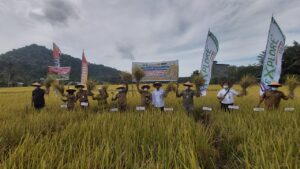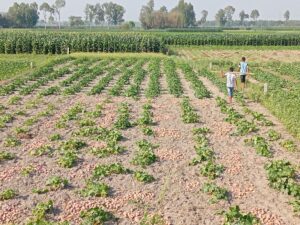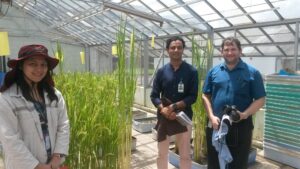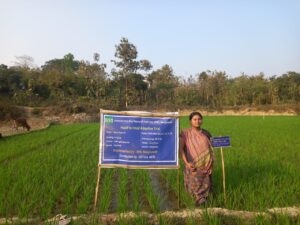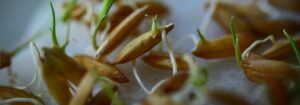Rice is life for nearly 3.5 billion people around the globe, especially in Asia, but, before people came to dominate the Asian landscape, many organisms had evolved to exploit this nutritious group of swamp grasses. Today, we call these other rice-consuming organisms pests and diseases as they compete with us and our growing population for the fixed resources of the Earth.
One particular group that farmers target is the granivorous or seed-eating birds, and, although some less specialized birds such as sparrows are faring well in this fight, many of the grass finches (Estrillidae, any of several small finch-like birds found from Africa across Asia and into Australasia.), once considered pests, are rapidly declining.
Information on how to reduce the damage caused by birds to rice production is available from the International Rice Research Institute (IRRI) and government agencies but precious little information exists on preserving the avian diversity of cultivated rice ecosystems, especially when the opportunity cost might just be a farmer’s next meal. Advocated bird control measures range from passive and active scaring methods (using visual and sonic cues) to active trapping and brutal extermination such as stamping on the netted birds as is promoted in Sabah, Malaysia.
The most specialized rice eater of all the granivorous birds is the Java sparrow or Java rice bird, known scientifically as Padda oryzivora, which literally means “rice eater of the field.” In the Philippines, this bird is also known as mayang costa. The Java sparrow is the largest of the estrillid finches. Its huge red beak is uniquely adapted to dehull even mature rice—a trick that is beyond the ability of most other finches. Hence, it has become an unwelcome competitor for cultivated rice crops.
It is believed that, before the advent of rice cultivation, these birds lived in the savanna and woodland surrounding swamps dominated by wild rice species in Java and Bali, Indonesia. As rice cultivation developed, the Java sparrow also spread out along with it.
This unwitting partnership between humans, their rice, and the Java sparrow worked well until the human population grew and the increase in rice cultivation started to encroach on the birds’ natural habitat: the ecotone (a transition area between two adjacent but different patches of landscape, such as forest and grassland) between the rice paddy where the birds fed and the trees and structures where they nested. Now, Java sparrows are in danger of becoming extinct in Indonesia. Although the species may now be arguably regarded as valuable in Indonesia, the Java sparrow is still considered a feral pest in Christmas Island, Hawaii, Fiji, and the Philippines. In many places where these birds now live, they have been relentlessly hunted not just because they are considered as rice pests but also because of their desirability as caged birds.
Ironically, Java sparrows are one of the easiest species to breed in captivity. However, economic circumstances and poor regulatory control in Indonesia favor the movement of the remaining wild birds from the fields to a life of barren captivity as most owners are keepers rather than breeders of birds. The closely related Timor sparrow (P. fuscata) is even more threatened by these processes and the genetic integrity of the few captive populations held outside the Indonesian archipelago is threatened by hybridization with the Java sparrow by careless avicultural practitioners.
With few exceptions, grass finches are all adapted to eat grass seeds although some species supplement the diet of their hatchlings with insects during the breeding season. Reproductive success in estrillid finches largely depends on the grasses they feed upon. In rice and other grasses, all the protein that will ever be stored by the grain is translocated into it during the first week after pollination while the endosperm is liquid. This proteinrich milk is what sustains most estrillid nestlings in the wild, but, to have a continuous supply requires a diversified landscape containing a mosaic of genotypes at different stages of growth. Unfortunately for the birds, modern agricultural practices seek to shorten the period until maturity and to synchronize grain filling not just within a plant or a single crop but across the landscape.
For millennia, the landscape across Asia was a mixture of rice paddies, primary and secondary forest, isolated villages, and urban centers. This suited many granivorous birds. The lack of temporal and spatial continuity between crops isolated the birds, and also helped contain outbreaks of plant diseases and pests.
After World War II, modern agricultural techniques were introduced. Productivity went up, and the barriers that separated rice paddies started to disappear, creating the present agroecological landscape. These changes have not only shrunk the food supply for the specialized granivorous birds but have also reduced the available nesting sites since none of the granivorous birds actually nest in the rice fields. They do, however, need close access to rice fields and other seeding grasses in order to raise their young.
Weeds constitute an alternative seed source within a rice crop and, in fact, many estrillids, particularly the munias (Lonchura spp.), prefer barnyard grass (Echinochloa sp.) over rice. Of course, no farmer would want to waste space, water, fertilizer, and insect control measures, or other resources, to grow food for birds when those resources could be used to grow more food for the family or for trade, so weeds are removed or minimized within a crop
As the human population increases, the number of commensal species that exploit the anthropogenic landscape has decreased but there are some winners. The Eurasian tree sparrow, in particular, has adapted well in this competitive environment. The protein requirements of nestling sparrows do not depend on immature milk-seed, but rather on insects that abound in a well-functioning paddy. Most estrillids nest in trees or shrubs but a few, such as the Padda spp., are cavity nesters. They use natural tree hollows and rock crevices or, in developed landscapes, they opt for roof cavities and other spaces within buildings. This habit places them in direct competition with the worst of their avian competitors, the Eurasian tree sparrow. Increasing affluence too can have a direct effect as buildings are repaired and construction standards are introduced, which reduce the available nesting opportunities for cavity-nesting birds.
So, what hope is there for the Java sparrow? It may be endangered in its home in Indonesia, but it is secure where it has established feral populations and also in captivity. Diminishing nesting opportunities can be overcome by providing artificial nesting boxes as was demonstrated during the restoration of the Prambanan Temple in Java. Increasing affluence in Indonesia has brought about not just a larger population that wants to keep birds, but a more educated population that wants to preserve them in their native habitat—and this should drive the political will to enforce regulatory controls on trade in endangered species. Ecotourism and bird watching bring millions of dollars of foreign revenue to Indonesia each year. Visiting Java would not be complete without seeing the Java sparrow. The future of the Java sparrow and every species lies with the collective responsibility of humanity to control its own population and its impact so that Earth remains a diverse, healthy, and resilient place for all its inhabitants.
______________________________________________
Dr. Howell was an Australian research scientist working in IRRI’s Plant Breeding, Genetics, and Biotechnology Division. He came to IRRI in 2004 along with his wife, Melissa Fitzgerald, who headed the Grain Quality and Nutrition Center at IRRI.


